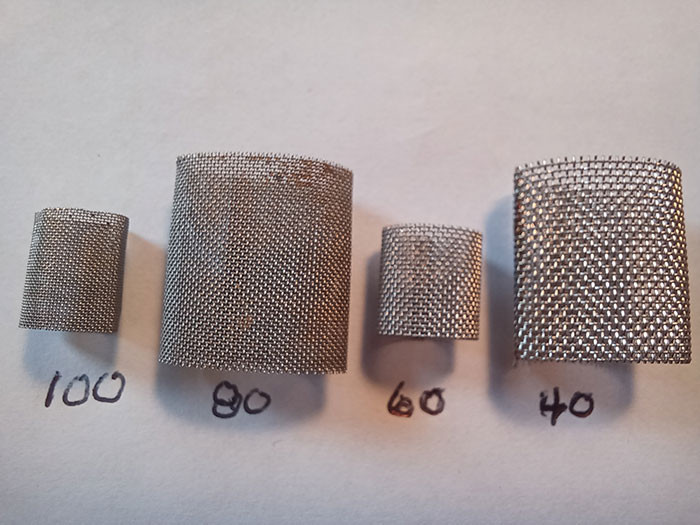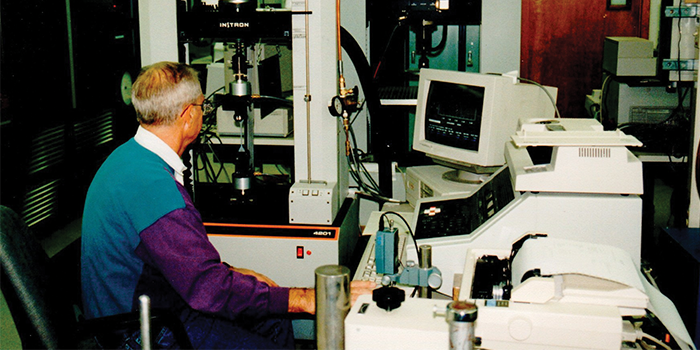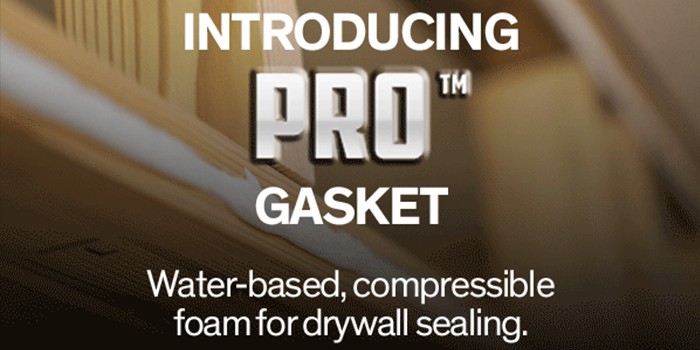The Great Filter Debate


Spray Foam Magazine – Winter 2024 – Ah yes, the big discussion at times, to use filter screens in the spray gun or not? If so, what is the proper size to use? This discussion, with various opinions, seems to come up on social media quite often. But who is correct here, and what is best?
To truly understand, one needs to take into account the purpose of the filter screens. They are not there just because the gun manufacturer puts them there. These filter screens are a form of a “safety” device, thus filtering out any particles that may be large and restrict or plug the orifices in the mix chamber. However, they should not be of this size to restrict flow into the mix chamber of the spray gun or filter out important solid components of the system.
Background
Some background information here as far as filter screen use in the plural, impingement mix spray gun. The earlier guns, like the old GUSMER Model D and the original GlasCraft Probler (P1), the only side that had a filter screen was the ISO side, or A-side, as noted here in North America. Why might one ask? Well since the Resin side of the system was fairly clean, low viscosity due to the use blowing agent of the times and no solids or self-reaction as with the ISO-side, so they were not considered for use. As technology in both equipment and system formulations evolved, especially with pigmented polyurea spray systems, the need to have filter screens on both the ISO and Resin side of the system became important. The ISO-side filter screens were 80-mesh, which is what we still find on most all spray guns used today.
So, the “science” behind the use of 80-mesh screens can be traced back to one of the original plural component spray guns, the GUSMER Model D, from the 1960’s (and even still used today by some). This mixing chamber is actually two slots for orifices (not round ports like we have today). These slots used a clean-out blade (not round drill bit) that was ~0.010 inches in thickness. By adjusting the valving rod travel, we called it “the point of valving,” one could “open” the slot to provide for the proper size orifice for the setup and system being used. Since the slot was 0.010 in size, made sense to use 80-mesh screens (0.007 inches in size) to filter particles, and this was the only size available. And as new gun set-ups came along, of course what is the best “compliment” in the industry, well copy what the others have, rather than understanding what is really required, i.e. 80-mesh screens vs proper 40-mesh screens.
Keep in mind that with the earlier spray foam systems, viscosity of the resin side was much lower due to the specific blowing agent used, Freon® R-11, being used at the time. With current polyurea based systems and spray foam resin side, viscosities are much higher now. Having too fine a mesh filter screen can actually lead to restricted materials flow, resulting in higher pressures being noted on the proportioning unit. This can and will affect proper mixing.
Filter Screens
Unfortunately, many are not familiar with mesh size with respect to the size of the “orifices” in the filter screens. One just usually re-orders what came with the gun and not understanding the importance of proper size with respect to orifice size in the mix chamber of the spray gun. Keep in mind, the larger the mesh number, the smaller the orifices in the filter screen. The following Table 1 provides for Mesh size with respect to “orifices” in the filter screen.
The following picture shows filter screens from 100, 80, 60 and 40-mesh, commonly available sizes for the spray guns. Though not each from the same gun, it does show the difference in mesh size. [IMAGE 2]


IMAGE 2: Filter screens – 40, 60, 80, and 100

IMAGE 3: Poked screen China
I recall in a polyurea applicator training course in China a few years back, the host company had supplied the equipment for the spray portion of the class. Prior to the class, had many comments from them about always an imbalance in pressure and plugging of the filter screens. Upon going over their spray gun, 80-mesh filter screens were present, but collapsed around the screen screw / check valve assembly. The best part was, they had solved their problem by using an ice pick to punch larger holes in the filter screen rather than acquiring the proper size screens…you can’t make this up!!! [IMAGE 3]
But it gets better! Even one airless spray gun manufacturer / supplier (who also makes and supplies the plural component spray guns) supplies an instructional chart showing the proper filter screen to use in the gun based upon the airless tip size. Wow, novel idea!! So why would it not make sense to do the same for the plural component spray guns?
For current polyurea spray elastomer and spray foam systems being used today, most spray gun setups are using a minimum orifice size of 0.042 – inches, such as the “01” or “AR4242” chamber for example. By referring to Table 1, a 40-mesh filter screen in the spray gun would be ideal. This still filters any such particles that may restrict or plug the orifices but does not restrict liquid material flow.
Are there situations that would call for removing the filters screens in the spray gun? Well, you bet there is, especially if the systems contain a high loading of solid fillers. A prime example here would be the fire-retardant systems of both coating and spray foam systems. One does not want to filter out these materials, as this is what provides the fire retardancy to the system. One also needs to use the proper size mix chamber such that these fillers “pass through” the orifices.
Conclusion
As noted in an earlier Spray Foam Magazine article in the Winter 2023 issue, the sole purpose of the proportioning pump is to meter material and provide the proper flow of the two components to the spray gun. What is done to restrict that material flow results in the pressures noted on the proportioning unit. The ideal situation is for the orifices in the mix chamber to restrict that flow, not the filter screens prior to the mix chamber. Filter screen size should be slightly smaller than the orifices of the mix chamber. Having too small a filter screen system can load up and over restrict that material flow prior to the mix chamber orifices. This can result in poor mixing of the system and spray pattern distortion.
If one is constantly having issues with ISO crystal formation in the systems and loading up the filter screens, unfortunately that can be due to equipment maintenance, use of non-standard material supply hoses, material storage and / or shut-down procedure being used.
Disqus website name not provided.









































